
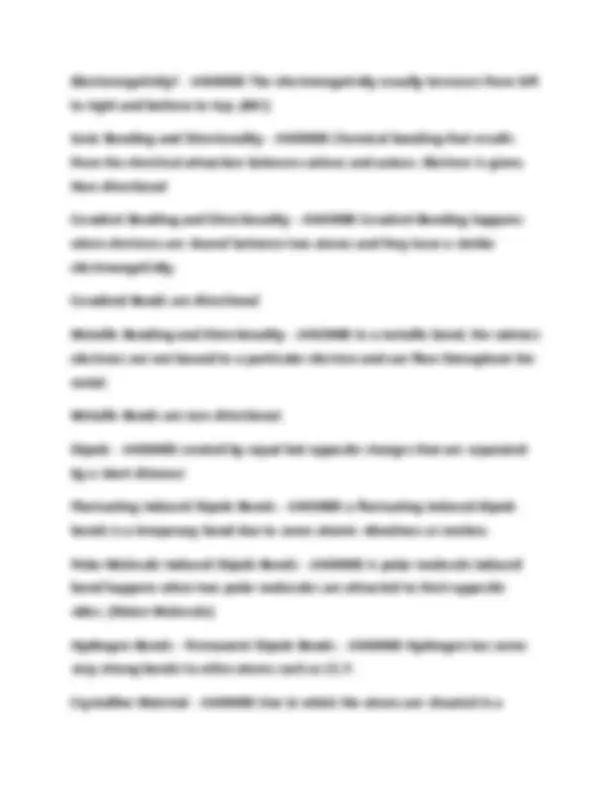
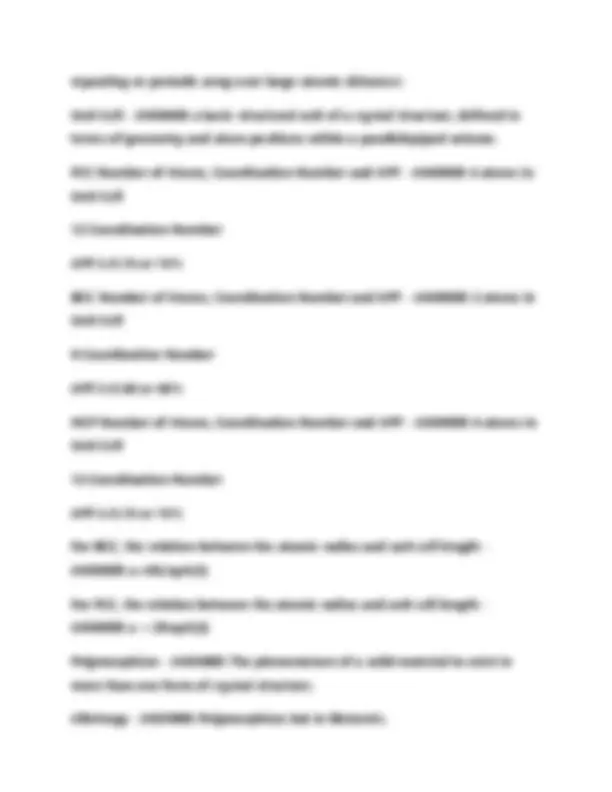
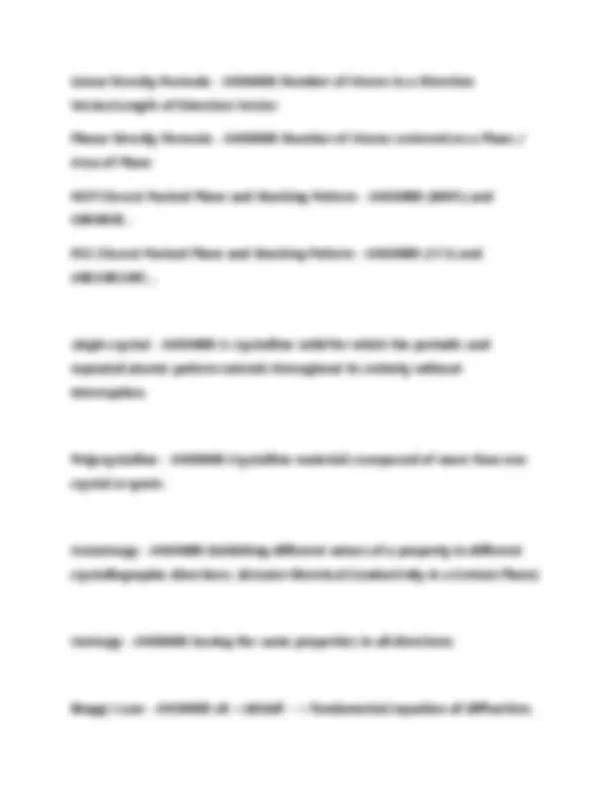
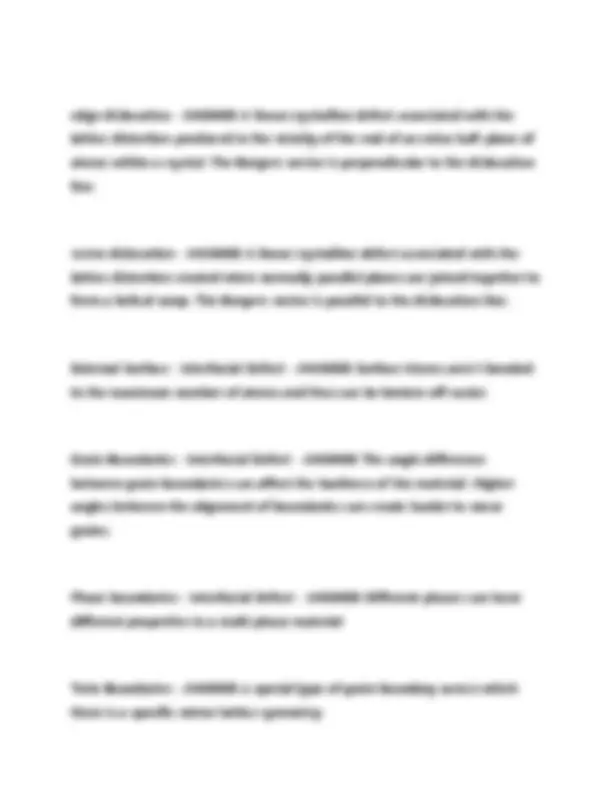
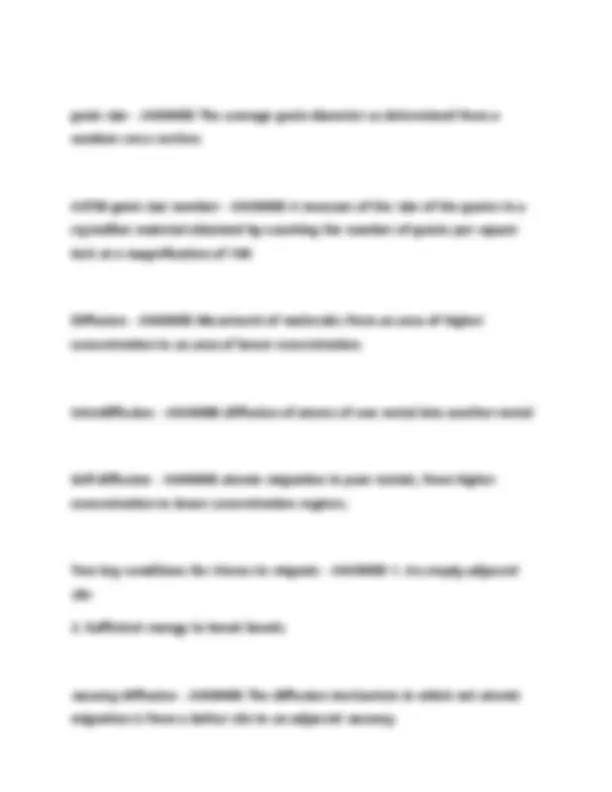
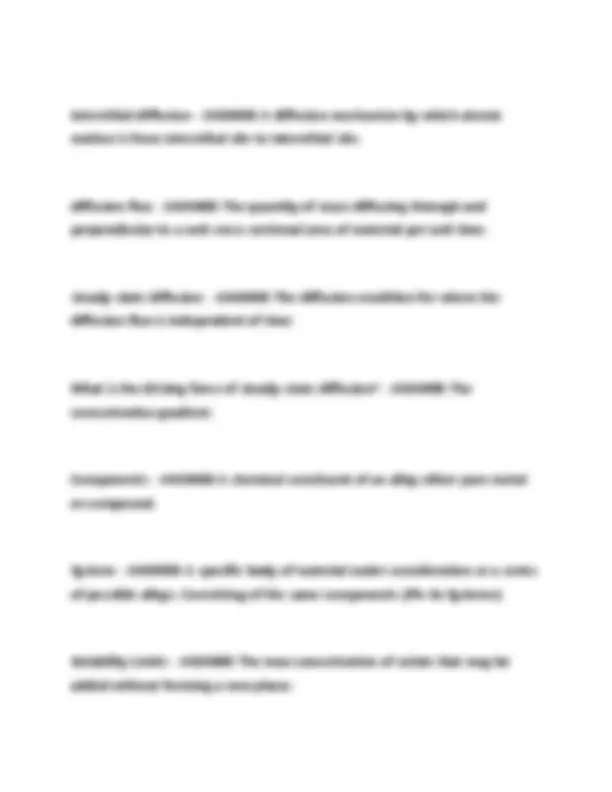


Study with the several resources on Docsity

Earn points by helping other students or get them with a premium plan


Prepare for your exams
Study with the several resources on Docsity

Earn points to download
Earn points by helping other students or get them with a premium plan
Community
Ask the community for help and clear up your study doubts
Discover the best universities in your country according to Docsity users
Free resources
Download our free guides on studying techniques, anxiety management strategies, and thesis advice from Docsity tutors
MTL200 Midterm Test With Correct Answers (graded a+).
Typology: Exams
1 / 12

This page cannot be seen from the preview
Don't miss anything!







What are the three primary material eras? - ANSWER Stone Age, Bronze Age, Iron Age
What are the four levels of Material Structures? - ANSWER Subatomic Structures, Atomic Structures, Micro structures, Macro structures
What are the three basic materials? - ANSWER Metals, Ceramics and Polymers
Advanced Materials - ANSWER semiconductors, biomaterials, smart materials, nanomaterials
atomic number - ANSWER the number of protons in the nucleus of an atom, usually equals the number of neutrons
Isotope - ANSWER Atoms of the same element that have different numbers of neutrons
formula for atomic mass - ANSWER Atomic Number + Neutrons
mole - ANSWER the SI base unit used to measure the amount of a substance 6.022 x 10^
Bohr's Atomic Model - ANSWER Atoms have levels surrounding the nucleus where electrons are found. Levels can hold different amounts of electrons depending on their distance from the nucleus.
Wave-Mechanical Model [Schrodinger's Model] - ANSWER Modern model of the atom, atoms have electrons in "orbitals" that are like clouds around the
nucleus
Quantum Numbers - ANSWER A set of four numbers that specify the properties of atomic orbitals and the properties of electrons in orbitals
Principal Quantum Number (s) - ANSWER symbolized by n, indicates the main energy level/shell occupied by the electron. N is the row in the periodic table
Secondary Quantum Number - ANSWER symbol = l; tells which sublevel the electron is on and determines the shape of the orbital; sublevels are repetitively numbered and also lettered
Valence Electrons - ANSWER The electrons in the outermost shell, which participate in the bonding between atoms.
Pauli Exclusion Principle - ANSWER An atomic orbital may describe at most two electrons, each with opposite spin direction
Bonding Energy - ANSWER The energy required to separate two atoms that are chemically bonded to each other to an infinite distance
What does a column group represent in a periodic table? - ANSWER Similar valence electron configurations/structure and chemical/physical properties
Electropositive Elements - ANSWER The elements have a tendency to release valence electrons (metals) and have a low electronegativity
Electronegative Elements - ANSWER The elements having a tendency to accept valence electrons (non-metals) and have a high electronegativity. [MC]
What is the general trend on the periodic table for increasing the
repeating or periodic array over large atomic distances
Unit Cell - ANSWER a basic structural unit of a crystal structure, defined in terms of geometry and atom positions within a parallelepiped volume.
FCC Number of Atoms, Coordination Number and APF - ANSWER 4 atoms in Unit Cell
12 Coordination Number
APF is 0.74 or 74%
BCC Number of Atoms, Coordination Number and APF - ANSWER 2 atoms in Unit Cell
8 Coordination Number
APF is 0.68 or 68%
HCP Number of Atoms, Coordination Number and APF - ANSWER 6 atoms in Unit Cell
12 Coordination Number
APF is 0.74 or 74%
For BCC, the relation between the atomic radius and unit cell length - ANSWER a=4R/sqrt(3)
For FCC, the relation between the atomic radius and unit cell length - ANSWER a = 2Rsqrt(2)
Polymorphism - ANSWER The phenomenon of a solid material to exist in more than one form of crystal structure.
Allotropy - ANSWER Polymorphism but in Elements.
Linear Density Formula - ANSWER Number of Atoms in a Direction Vector/Length of Direction Vector
Planar Density Formula - ANSWER Number of Atoms centered on a Plane / Area of Plane
HCP Closest Packed Plane and Stacking Pattern - ANSWER (0001) and ABABAB...
FCC Closest Packed Plane and Stacking Pattern - ANSWER (111) and ABCABCABC...
single crystal - ANSWER A crystalline solid for which the periodic and repeated atomic pattern extends throughout its entirety without interruption.
Polycrystalline - ANSWER Crystalline materials composed of more than one crystal or grain.
Anisotropy - ANSWER Exhibiting different values of a property in different crystallographic directions. (Greater Electrical Conductivity in a Certain Plane)
Isotropy - ANSWER having the same properties in all directions
Bragg's Law - ANSWER n λ =2dsin θ --> fundamental equation of diffraction.
are possible.
alloy - ANSWER A mixture of two or more metals
Two types of Solid Solution - ANSWER Substitutional and Interstitial
Factors affecting the Solubility of Substitutional Solid Solutions - ANSWER 1. Atomic Size
Weight Percentage - ANSWER C1 = m1/(m1+m2)
Atom Percentage - ANSWER C1' = (n_m1)/(n_m1+n_m2)
What is a dislocation? - ANSWER a linear or one-dimensional defect around which some of the atoms are misaligned.
Burgers vector - ANSWER A vector that denotes the magnitude and direction of lattice distortion associated with a dislocation.
edge dislocation - ANSWER A linear crystalline defect associated with the lattice distortion produced in the vicinity of the end of an extra half-plane of atoms within a crystal. The Burgers vector is perpendicular to the dislocation line.
screw dislocation - ANSWER A linear crystalline defect associated with the lattice distortion created when normally parallel planes are joined together to form a helical ramp. The Burgers vector is parallel to the dislocation line.
External Surface - Interfacial Defect - ANSWER Surface Atoms aren't bonded to the maximum number of atoms and thus can be broken off easier.
Grain Boundaries - Interfacial Defect - ANSWER The angle difference between grain boundaries can affect the hardness of the material. Higher angles between the alignment of boundaries can create harder to move grains.
Phase boundaries - Interfacial Defect - ANSWER Different phases can have different properties in a multi phase material
Twin Boundaries - ANSWER a special type of grain boundary across which there is a specific mirror lattice symmetry
interstitial diffusion - ANSWER A diffusion mechanism by which atomic motion is from interstitial site to interstitial site.
diffusion flux - ANSWER The quantity of mass diffusing through and perpendicular to a unit cross-sectional area of material per unit time.
steady-state diffusion - ANSWER The diffusion condition for where the diffusion flux is independent of time
What is the driving force of steady-state diffusion? - ANSWER The concentration gradient.
Components - ANSWER A chemical consituent of an alloy either pure metal or compound.
System - ANSWER A specific body of material under consideration or a series of possible alloys. Consisting of the same components (Pb-Sn Systems)
Solubility Limits - ANSWER The max concentration of solute that may be added without forming a new phase.
Phase - ANSWER A homogeneous portion in a system having uniform physical & chemical characteristics
What are the 4 characteristicts of a mictorstructure - ANSWER 1. # of Phase
The major factors affecting the structure - ANSWER 1. Alloying Elements
Equilibrium - ANSWER State of a system corresponding to the minimum free energy, where the phase characteristics can remain constant over an indefinite time period.
Free Energy - ANSWER A thermodynamic quantity that is a function of both the internal energy and entropy (or randomness) of a system. At equilibrium, the free energy is at a minimum.
Meta State - ANSWER Non equilibrium state that may persist for a long time.